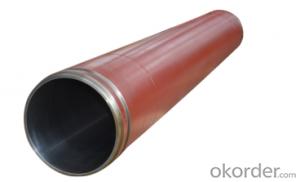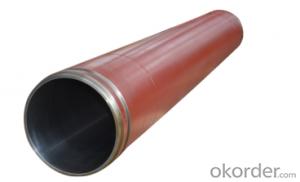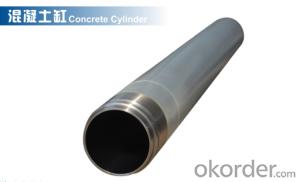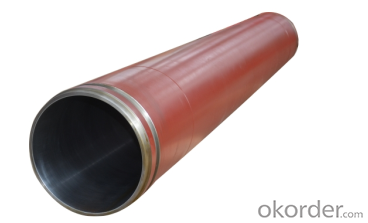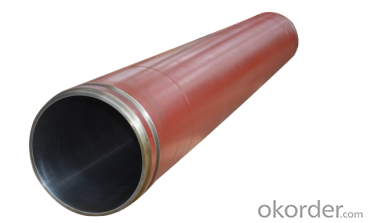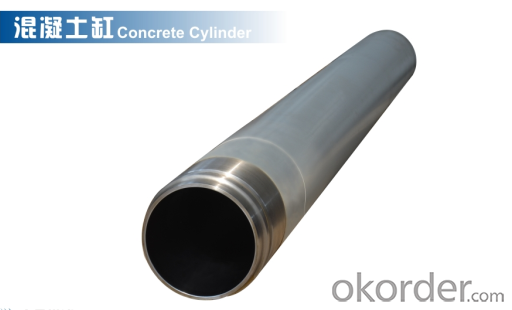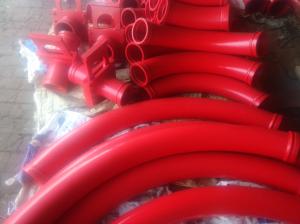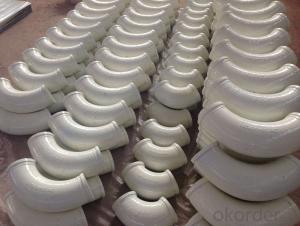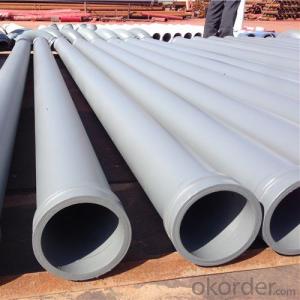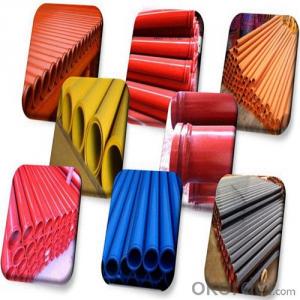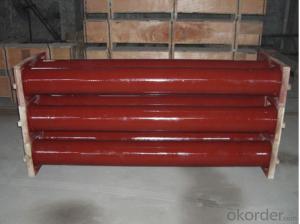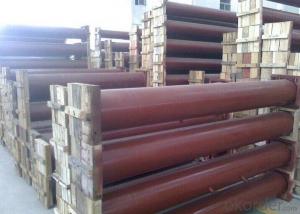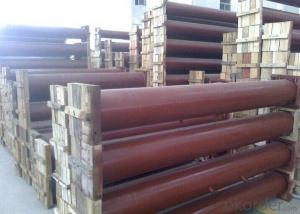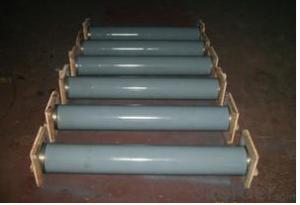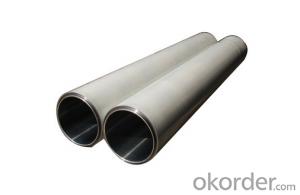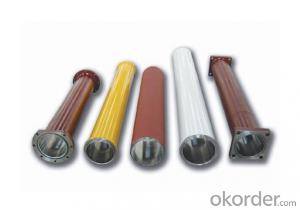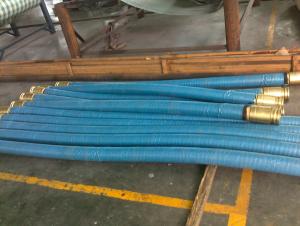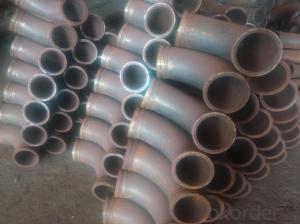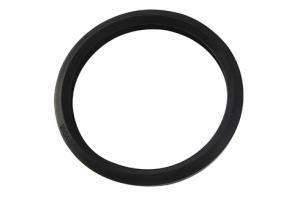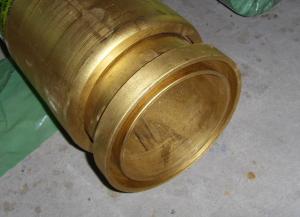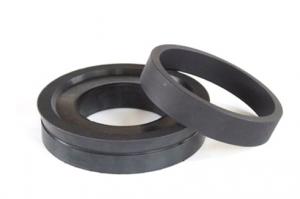PUMPING CYLINDER(SCHWING) I.D.:DN200 CR. THICKNESS :0.25MM-0.3MM LENGTH:2125MM
- Loading Port:
- Shanghai
- Payment Terms:
- TT OR LC
- Min Order Qty:
- 2 pc
- Supply Capability:
- 1000 pc/month
OKorder Service Pledge
OKorder Financial Service
You Might Also Like
Product Description:
The Concrete Pump Delivery Cylinder DN200*2125 normally made by steel material No. C45. according to customer’s requests, and also package in bundles or nude packing directly put into container.
Scope of Application of the Cylinders
The Pump Delivery Cylinder DN200*2125 is a concrete pumping for combined use with other concrete pumps in concrete pumping operations. It can be widely used in the construction of various types of concrete structures like industrial and civil buildings, bridges, roads, and other types of infrastructure.
This Cylinder DN200*2125 can only be used in concrete pump construction operations, but not in any other operations, like dragging, moving, or hoisting heavy articles or personnel. The pipe is also not allowed to be used in any location where any combustible or explosive material exists or a cave-in may occur.
Specifications:
Concrete Pump Delivery Cylinder DN200*2125
1. Capacity: 60,000~80,000cbm
2. Size: DN180, DN200, DN230..
4. Brand: SANY
5. Material: C45
6. Quenching and tempering to improve the hardness to HB241-280
7. Inner wall chrome thickness is 0.25-0.30mm, hardness HV820-900.
Product Advantages:
OKorder's Cylinders DN200*2125 Channels are durable, strong, and safety.
Main Product Features:
· Premium quality
· Prompt delivery & seaworthy packing (10-20 days)
Reliable performance
Easy to weld
High safety.
· Professional Service
· Competitive pricing
Measuring of wall thickness from the outside
Low purchase cost
FAQ:
Q1: How long about delivery time about DN200*2125?
A1: Normally we keep the raw materials for old customers and sometime we also keep stock products to make sure delivery time in any emergency cases.
Q2: How do we guarantee the quality of our Cylinders DN200*2125?
A2: We have established an advanced quality management system which conducts strict quality tests at every step, from raw materials to the final product. At the same time, we provide extensive follow-up service assurances as required.
Q3: How soon can we receive the product after purchase?
A3: Within three days of placing an order, we will book the vessel for goods. The specific shipping date is dependent upon international and government factors, but is typically10 to 30 workdays.
Q4: If we can produce some Cylinders according to customers request?
A4: Yes, we can produce Cylinders DN200*2125 according to the difference country situations to make it suitable to the market and customers. We have very professional technical team to make the design.
Q5: How to make a quick resolution for after service?
A5: OKorder and our manufacture both have overseas branches all-around of world, If needed,
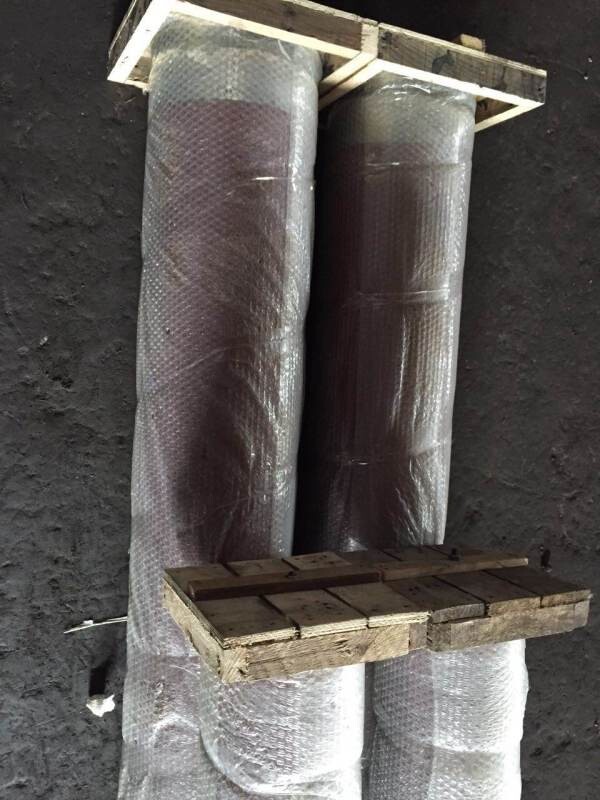
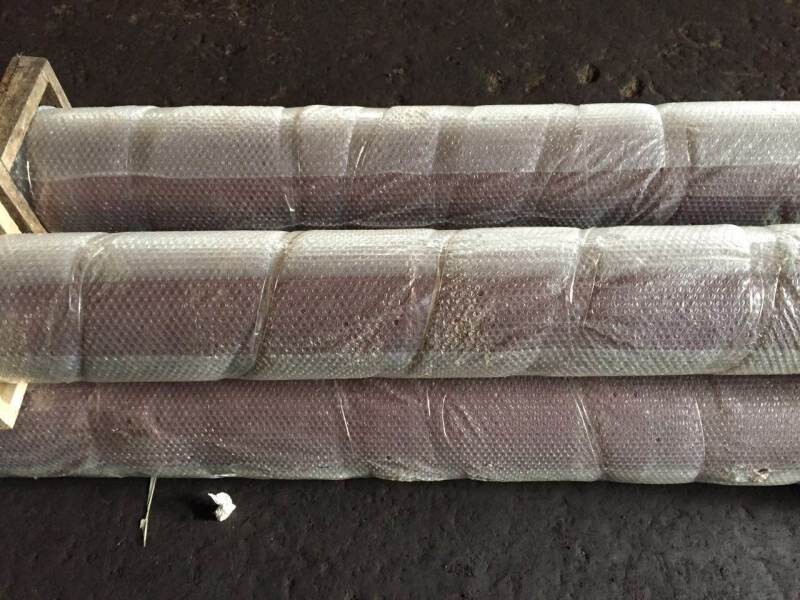
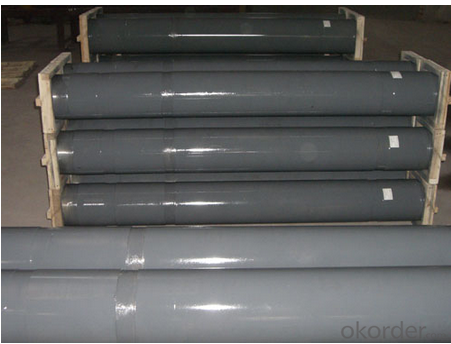
- Q: How does a concrete pump agitator motor prevent concrete from settling?
- Constantly agitating the mixture, a concrete pump agitator motor prevents the settling of concrete. Typically equipped with rotating paddles or blades inside the mixing drum, the motor ensures that the concrete remains in a homogeneous state. During transportation, concrete tends to separate as gravity and the natural settling of heavier aggregates take effect. This can lead to a non-uniform consistency, with denser materials sinking and water rising. To counteract this settling process, the agitator motor stirs the concrete continuously. By creating a turbulent flow within the mixing drum, the rotating paddles or blades prevent the heavier aggregates from settling, thus maintaining a consistent mixture. This agitation helps distribute the cement, aggregates, water, and any additional additives evenly throughout the concrete, resulting in a more reliable and uniform end product. By preventing concrete settling, the agitator motor ensures that the mixture remains consistently workable, free from blockages or inconsistencies, and suitable for pumping or pouring. This is particularly crucial in construction projects that require precise and consistent concrete placement. In conclusion, the agitator motor in a concrete pump prevents settling by continuously agitating the mixture, thus maintaining its homogeneity and ensuring a consistent flow during pumping or pouring operations.
- Q: How can a faulty filter affect the pumping process?
- A faulty filter can impede the pumping process by allowing debris, contaminants, or particles to pass through and clog or damage the pump components. This can result in reduced efficiency, increased wear and tear, decreased flow rates, and potential pump failure.
- Q: What are the different types of concrete pump hopper agitator shaft seals?
- There are various types of concrete pump hopper agitator shaft seals, including packing seals, mechanical seals, and lip seals.
- Q: Are there any specific maintenance practices for concrete pump spare parts?
- Yes, there are specific maintenance practices that should be followed for concrete pump spare parts. Firstly, it is important to regularly inspect the spare parts for any signs of wear or damage. This includes checking for cracks, leaks, or any other visible defects. If any issues are detected, the spare parts should be replaced or repaired immediately to prevent further damage. Secondly, it is crucial to clean the spare parts on a regular basis. Concrete pump spare parts often come into contact with cement, water, and other substances that can cause build-up and affect their performance. Regular cleaning will help remove any debris or residue, ensuring that the spare parts function optimally. Additionally, lubrication is an essential maintenance practice for concrete pump spare parts. Lubricating moving components such as bearings, seals, and pistons will help reduce friction and wear, extending the lifespan of the spare parts. It is important to use the correct lubricants specified by the manufacturer and follow their guidelines for application. Furthermore, proper storage of spare parts is also important for their maintenance. They should be stored in a clean and dry environment, away from any chemicals or other substances that could damage them. Spare parts should also be stored in a way that protects them from physical damage, such as being dropped or bumped. Lastly, it is recommended to follow the manufacturer's guidelines and recommendations for maintenance and replacement intervals. Regular servicing and inspections by qualified technicians can help identify any potential issues early on and prevent major breakdowns or failures. In conclusion, following specific maintenance practices such as regular inspection, cleaning, lubrication, proper storage, and adherence to manufacturer's guidelines are crucial for ensuring the optimal performance and longevity of concrete pump spare parts.
- Q: What are some common issues with concrete pump pipes and how can they be prevented?
- Concrete pump pipes can experience several common issues, including blockages, leaks, and wear and tear. These problems can be avoided by implementing appropriate maintenance and operational practices. 1. Blockages: Concrete hardening inside the pipe can obstruct the flow, resulting in blockages. Regularly cleaning the pipes after each use is crucial to prevent blockages. Flushing the pipes with water or using a high-pressure air hose can eliminate any remaining material and prevent buildup. Furthermore, using concrete mixtures with the correct consistency and avoiding excessive use of additives can minimize the chances of blockages. 2. Leaks: Cracks or gaps in the pipe can cause concrete to leak out. Regularly inspecting the pipes is vital to detect any signs of damage or wear. Promptly repairing or replacing damaged sections can prevent leaks. It is also essential to use high-quality pipes that resist abrasion and chemical corrosion as they are less likely to develop leaks. 3. Wear and Tear: The operation of concrete pump pipes exposes them to significant stress and abrasion. This can eventually lead to wear and tear, resulting in weakened pipes or even breakages. To prevent excessive wear, it is important to utilize pipes made from durable materials like hardened steel or composite materials. Regularly inspecting the pipes for signs of wear, such as thinning or deformation, and replacing them as needed can help prevent sudden failures. 4. Pipe movement and alignment issues: During operation, concrete pump pipes may shift or become misaligned, which can decrease efficiency and potentially cause damage. To prevent this, ensure that the pipes are securely fastened to the pump and properly aligned. Using clamps and brackets or employing anti-vibration measures can help maintain the stability and alignment of the pipes during pumping operations. 5. Operator errors: Improper handling and operation can also contribute to problems with concrete pump pipes. Operators should receive adequate training in pump operation and pipe handling. Following recommended operating procedures, avoiding excessive pressure or flow rates, and exercising caution while maneuvering the pipes can prevent unnecessary strain and damage. In conclusion, proactive maintenance, proper handling, and the use of high-quality pipes can greatly reduce common issues with concrete pump pipes, ensuring smooth and efficient concrete pumping operations.
- Q: How often should carbide wear plates be replaced in a concrete pump?
- The replacement frequency of carbide wear plates in a concrete pump is dependent on various factors. These include the type and quality of the plates, the intensity of usage, and the specific operating conditions of the pump. Carbide wear plates are designed to withstand the abrasive nature of concrete and generally have a longer lifespan compared to traditional steel plates. However, they are not immune to deterioration and will eventually wear down over time. A good practice is to regularly inspect the wear plates and assess their condition. If there are visible cracks, excessive erosion, or a decrease in concrete flow performance, it is time to consider replacing them. Replacement intervals can vary, ranging from annual replacements to several years. To extend the lifespan of carbide wear plates, proper maintenance and care are crucial. This includes regular cleaning, ensuring proper lubrication, and avoiding excessive pressure or abuse during operation. By conducting regular maintenance, the wear plates can last longer and replacements can be less frequent. It is advisable to consult the manufacturer's guidelines or seek advice from a professional concrete pump technician to determine the specific replacement interval for carbide wear plates in a particular pump model. Their expertise and knowledge will provide accurate recommendations based on the specific conditions and usage of the concrete pump.
- Q: Can I get spare parts for concrete pump hydraulic systems?
- Yes, it is possible to get spare parts for concrete pump hydraulic systems. Many manufacturers and suppliers offer a wide range of spare parts specifically designed for concrete pump hydraulic systems. These spare parts can include components such as hydraulic cylinders, valves, hoses, filters, seals, and other essential parts. It is important to identify the specific make and model of the concrete pump hydraulic system to ensure compatibility when purchasing spare parts. Additionally, it is recommended to source spare parts from reputable suppliers or manufacturers to ensure quality and reliability.
- Q: How do concrete pump spare parts contribute to the overall performance of the pump?
- Enhancing the overall performance of the pump, concrete pump spare parts play a crucial role. These spare parts are specifically designed to endure the harsh and demanding conditions of pumping concrete, guaranteeing the efficiency and longevity of the pump. An important factor in the pump's overall performance is the ability of concrete pump spare parts to enhance pumping capacity and efficiency. These spare parts, including pump cylinders, pistons, and valves, are designed to ensure a consistent and smooth flow of concrete without any interruptions. By maintaining a steady flow, these spare parts maximize the pump's capacity, enabling it to handle larger volumes of concrete in less time. Furthermore, concrete pump spare parts contribute to the pump's performance by improving its durability and reliability. These spare parts are made from high-quality materials like hardened steel and wear-resistant alloys, specifically chosen to withstand the abrasive nature of concrete. This ensures that the pump can operate continuously without experiencing premature wear or failure. Concrete pump spare parts also ensure the safety of the pump operators and the environment. For instance, wear plates and cutting rings prevent concrete leakage, reducing the risk of accidents and environmental contamination. Similarly, seals and gaskets provide a secure and tight connection between different components, preventing leaks or malfunctions. Moreover, concrete pump spare parts reduce downtime and maintenance costs. As these spare parts undergo wear and tear during operation, they are designed to be easily replaceable. This allows for quick and efficient repair or replacement of damaged parts, minimizing the pump's downtime. Additionally, using genuine and high-quality spare parts reduces the need for frequent repairs and maintenance, resulting in lower overall maintenance costs. In conclusion, concrete pump spare parts are vital components that significantly contribute to the pump's overall performance. They enhance its pumping capacity, durability, and reliability, ensuring a smooth and efficient operation. Furthermore, these spare parts promote safety, reduce downtime, and minimize maintenance costs, making them indispensable for the optimal performance of concrete pumps.
- Q: What is the importance of a concrete pump control valve?
- A concrete pump control valve plays a critical role in the operation of a concrete pump. It is an essential component that allows for precise and efficient control of the flow and pressure of the concrete being pumped. The importance of a concrete pump control valve can be understood by considering its various functions. Firstly, it regulates the flow of concrete from the hopper to the pumping cylinders. By adjusting the valve, operators can increase or decrease the flow rate to match the specific requirements of the project. This ensures that the right amount of concrete is being pumped, preventing wastage and optimizing productivity. Secondly, the control valve allows for precise control of the pressure in the pumping cylinders. By adjusting the valve, the operator can increase or decrease the pressure to maintain a consistent and steady flow of concrete. This is crucial in preventing blockages or clogs in the concrete pump system, which can lead to downtime and costly repairs. Furthermore, the control valve enables the operator to switch between different pumping modes, such as high-pressure pumping or low-pressure spraying. This versatility allows for the efficient execution of a wide range of concrete pumping tasks, from pouring foundations to spraying concrete for decorative purposes. In addition to its functional importance, a concrete pump control valve also contributes to the safety of the pumping operation. It allows operators to stop or reverse the flow of concrete in case of emergencies or equipment malfunctions. This feature ensures that any potential hazards are quickly addressed, minimizing the risk of accidents and injuries. Overall, the importance of a concrete pump control valve lies in its ability to provide precise control over the flow and pressure of concrete during pumping operations. It ensures efficiency, productivity, versatility, and safety, making it an indispensable component of any concrete pumping system.
- Q: How long does it take to replace a specific concrete pump spare part?
- The time it takes to replace a specific concrete pump spare part can vary depending on several factors. Firstly, the complexity and size of the part will play a role in the time required for replacement. Simple and smaller parts may be replaced relatively quickly, while larger and more intricate parts may take longer. Secondly, the availability of the spare part is crucial. If the part is readily available and in stock, the replacement process can be expedited. However, if the part needs to be ordered or sourced from a supplier, there may be a delay in receiving it, which will extend the overall replacement time. Furthermore, the expertise and experience of the person or team performing the replacement will impact the duration as well. Trained and skilled professionals will likely be able to complete the replacement more efficiently compared to those with limited knowledge or experience. Lastly, unforeseen complications or issues during the replacement process can also affect the time required. It is possible that additional repairs or adjustments may be needed, which could prolong the replacement time. In summary, the time it takes to replace a specific concrete pump spare part depends on the complexity and size of the part, its availability, the expertise of the individuals performing the replacement, and any unforeseen complications that may arise. Therefore, it is challenging to provide an exact timeframe without considering these factors.
Send your message to us
PUMPING CYLINDER(SCHWING) I.D.:DN200 CR. THICKNESS :0.25MM-0.3MM LENGTH:2125MM
- Loading Port:
- Shanghai
- Payment Terms:
- TT OR LC
- Min Order Qty:
- 2 pc
- Supply Capability:
- 1000 pc/month
OKorder Service Pledge
OKorder Financial Service
Similar products
Hot products
Hot Searches
Related keywords
